Electronic states with high amounts of spin are central to the understanding of novel physical phenomena such as energy collection in organic photovoltaics and unconventional high-spin superconductivity. Identifying arrangement of spins is also paramount for the accurate readout of quantum information stored in silicon quantum dots—‘artificial atoms’ where electrons can be collected on-demand—which are particularly promising for large-scale quantum computing.

A spin quintet consisting of four spin-aligned unpaired electrons within a pair of silicon quantum dots
Together with a team of researchers from the University of Cambridge, Hitachi Cambridge Laboratory, University of Bristol, CEA-Grenoble and Université Grenoble Alpes, Theodor Lundberg (NanoDTC Student c2017) has developed a new, comprehensive method for identifying spin arrangements in quantum dots, which has led to the discovery of novel high-spin states in a pair of silicon quantum dots.
The researchers achieve this milestone by developing an energy spectroscopy tool based on radio-frequency sensing and the application of varying magnetic fields. This experimental technique is supported by a theoretical model, also developed by the team, that expands the standard description of Pauli spin blockade—the typical method for sensing spin arrangements in quantum dots—to include high-spin states.
“Using our methodology, we were able to discover a novel spin system not previously identified in quantum dots: a spin quintet, a multi-particle state consisting of four unpaired electrons”, said lead-author Theodor.
The team, which report their results in the journal Physical Review X, use this finding as an opportunity to investigate the spin quintet’s dynamic spin properties, thereby assessing its suitability for quantum computing applications.
“Our methods and results provide a pathway for reconstructing the energy spectra of complex spin systems and open the possibility of using quantum dots as a tunable testbed for studying the interactions and dynamics of high-spin systems,” said Theodor.
Reference:
T. Lundberg et al. ‘Spin Quintet in a Silicon
Double Quantum Dot: Spin Blockade and Relaxation’. Physical
Review X (2020). DOI: 10.1103/PhysRevX.10.041010

